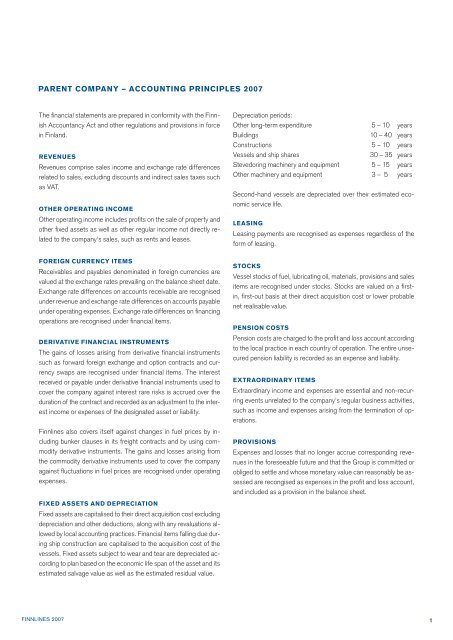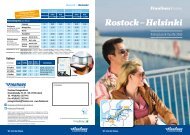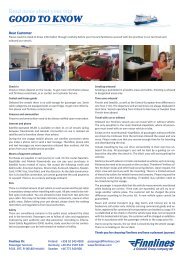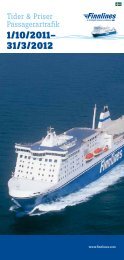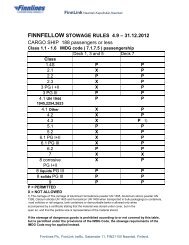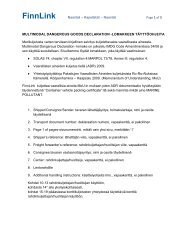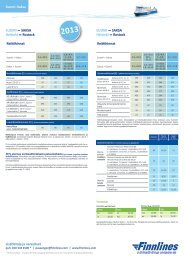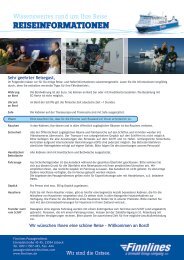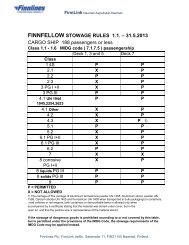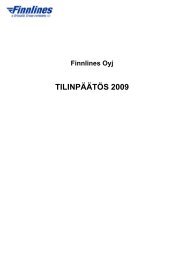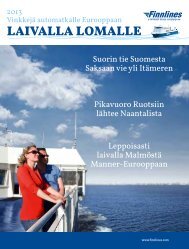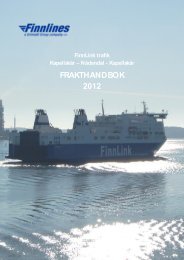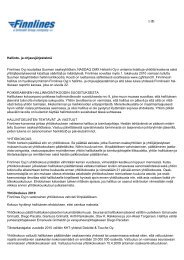Annual Report and Financial Statements 2007 - Finnlines
Annual Report and Financial Statements 2007 - Finnlines
Annual Report and Financial Statements 2007 - Finnlines
You also want an ePaper? Increase the reach of your titles
YUMPU automatically turns print PDFs into web optimized ePapers that Google loves.
paRent cOmpany – accOunting pRinciples <strong>2007</strong><br />
The financial statements are prepared in conformity with the Finnish<br />
Accountancy Act <strong>and</strong> other regulations <strong>and</strong> provisions in force<br />
in Finl<strong>and</strong>.<br />
Revenues<br />
Revenues comprise sales income <strong>and</strong> exchange rate differences<br />
related to sales, excluding discounts <strong>and</strong> indirect sales taxes such<br />
as VAT.<br />
OtheR OpeRating incOme<br />
Other operating income includes profits on the sale of property <strong>and</strong><br />
other fixed assets as well as other regular income not directly related<br />
to the company's sales, such as rents <strong>and</strong> leases.<br />
FOReign cuRRency items<br />
Receivables <strong>and</strong> payables denominated in foreign currencies are<br />
valued at the exchange rates prevailing on the balance sheet date.<br />
Exchange rate differences on accounts receivable are recognised<br />
under revenue <strong>and</strong> exchange rate differences on accounts payable<br />
under operating expenses. Exchange rate differences on financing<br />
operations are recognised under financial items.<br />
DeRivative <strong>Financial</strong> instRuments<br />
The gains of losses arising from derivative financial instruments<br />
such as forward foreign exchange <strong>and</strong> option contracts <strong>and</strong> currency<br />
swaps are recognised under financial items. The interest<br />
received or payable under derivative financial instruments used to<br />
cover the company against interest rare risks is accrued over the<br />
duration of the contract <strong>and</strong> recorded as an adjustment to the interest<br />
income or expenses of the designated asset or liability.<br />
<strong>Finnlines</strong> also covers itself against changes in fuel prices by including<br />
bunker clauses in its freight contracts <strong>and</strong> by using commodity<br />
derivative instruments. The gains <strong>and</strong> losses arising from<br />
the commodity derivative instruments used to cover the company<br />
against fluctuations in fuel prices are recognised under operating<br />
expenses.<br />
FixeD assets anD DepReciatiOn<br />
Fixed assets are capitalised to their direct acquisition cost excluding<br />
depreciation <strong>and</strong> other deductions, along with any revaluations allowed<br />
by local accounting practices. <strong>Financial</strong> items falling due during<br />
ship construction are capitalised to the acquisition cost of the<br />
vessels. Fixed assets subject to wear <strong>and</strong> tear are depreciated according<br />
to plan based on the economic life span of the asset <strong>and</strong> its<br />
estimated salvage value as well as the estimated residual value.<br />
FINNLINES <strong>2007</strong><br />
Depreciation periods:<br />
Other long-term expenditure 5 – 10 years<br />
Buildings 10 – 40 years<br />
Constructions 5 – 10 years<br />
Vessels <strong>and</strong> ship shares 30 – 35 years<br />
Stevedoring machinery <strong>and</strong> equipment 5 – 15 years<br />
Other machinery <strong>and</strong> equipment 3 – 5 years<br />
Second-h<strong>and</strong> vessels are depreciated over their estimated economic<br />
service life.<br />
leasing<br />
Leasing payments are recognised as expenses regardless of the<br />
form of leasing.<br />
stOcks<br />
Vessel stocks of fuel, lubricating oil, materials, provisions <strong>and</strong> sales<br />
items are recognised under stocks. Stocks are valued on a firstin,<br />
first-out basis at their direct acquisition cost or lower probable<br />
net realisable value.<br />
pensiOn cOsts<br />
Pension costs are charged to the profit <strong>and</strong> loss account according<br />
to the local practice in each country of operation. The entire unsecured<br />
pension liability is recorded as an expense <strong>and</strong> liability.<br />
extRaORDinaRy items<br />
Extraordinary income <strong>and</strong> expenses are essential <strong>and</strong> non-recurring<br />
events unrelated to the company's regular business activities,<br />
such as income <strong>and</strong> expenses arising from the termination of operations.<br />
pROvisiOns<br />
Expenses <strong>and</strong> losses that no longer accrue corresponding revenues<br />
in the foreseeable future <strong>and</strong> that the Group is committed or<br />
obliged to settle <strong>and</strong> whose monetary value can reasonably be assessed<br />
are recongised as expenses in the profit <strong>and</strong> loss account,<br />
<strong>and</strong> included as a provision in the balance sheet.<br />
1


